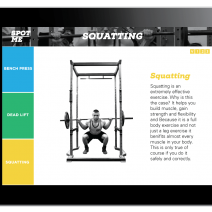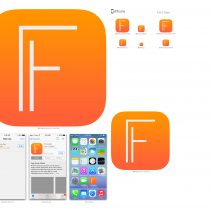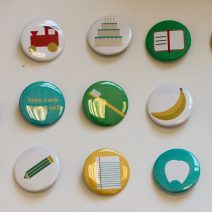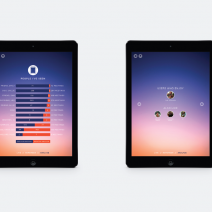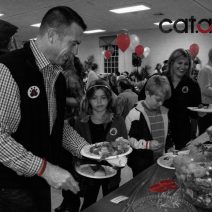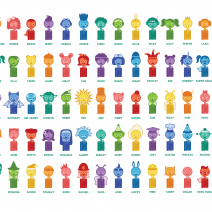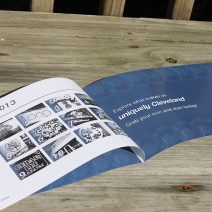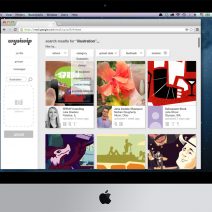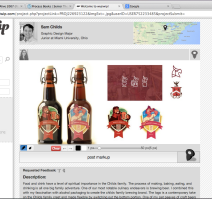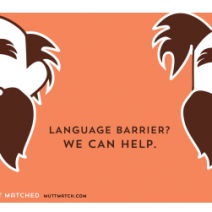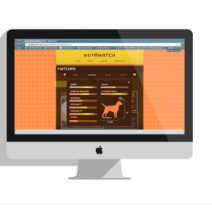Introducing the Senior Graphic Design Projects 2014

Each spring I work with the seniors to develop their senior thesis projects and exhibitions. The 2014 thesis theme was Design for the Social Good. Scroll down to check out this year’s senior work. Congratulations and best wishes to all our seniors!
Aaron Retter: Spot Me
 Design Problem: College students working out do not use the proper form for weight lifting exercises. This results in serious injury, and mainly because they are unaware.
Design Problem: College students working out do not use the proper form for weight lifting exercises. This results in serious injury, and mainly because they are unaware.
Target Audience: The target audience of this problem are college students who work out on a regular basis.
Solution: Spot Me is an ipad app that provides visual understanding and instructions on how to lift weights with proper technique to prevent injury. The app is broken down into the 3 most common lifts done at the gym, which are the three most common lifts that cause injury, and they are: bench pressing, dead lifting and squatting. Spot me, combined with other design elements becomes more than just an app, but an entire first hand learning experience. Design elements that tie to this include signage, vinyl floor decals and informational takeaways.
Andrea Fiegel: Wee Spy
 Design Problem: Over 50% of calls to poison centers involve children under the age of five who consume products that look, smell or taste good. As medications become more common in American homes, exposure to prescription and nonprescription drugs are on the rise.
Design Problem: Over 50% of calls to poison centers involve children under the age of five who consume products that look, smell or taste good. As medications become more common in American homes, exposure to prescription and nonprescription drugs are on the rise.
Target Audience: I am targeting parents with children (5 and younger). Poisoning is one of the most common childhood injuries. This solution should also encourage parents to educate their children about poison to keep their household safe.
Solution: A customizable app that teaches children the difference between poisonous and harmless items. Parents upload photos and the child will choose if the item is healthy or poisonous. Audio and animation are included to add user experience.
Ann Sniechowski: Fresh Over Frozen
 Design Problem: Young adults do not fully understand the dangers of processed, chemically modified food. At the same time however, these young adults would like to live a healthier lifestyle, but do not know how
Design Problem: Young adults do not fully understand the dangers of processed, chemically modified food. At the same time however, these young adults would like to live a healthier lifestyle, but do not know how
Target Audience: Young adults, specifically ages 20-25
Design Solution: Fresh Over Frozen is an iPad application that provides healthy, single-serving alternatives to the name brand frozen meals. Not only does the app provide a solution and alternative to the chemically modified frozen foods, but it also educates the users on the dangerous ingredients, specifically the “Scary Seven” that includes High Fructose Corn Syrup, MSG, preservatives, trans-fat, and artificial colors, sweeteners, and flavors. Through development of an icon system, the app also informs the user what parts of their body these ingredients are a hazard to, as well how shows the user the rewarding benefits of choosing the fresh ingredients. This application is meant to show to rewards of choosing fresh by showing what the user is avoiding in the process as well. Fresh Over Frozen not only provides a simple, meaningful solution, but also informs the users of both the dangers and benefits of fresh and frozen ingredients in an easy, rewarding way.
Austin Li: Fribe
 Design Problem: Newly graduated college students who plan on moving to New York City find it particularly difficult to find the communities they belong to. This exists both on a physical and an emotional level interdependently due to the cultural differences, high living costs and lack of connections.
Design Problem: Newly graduated college students who plan on moving to New York City find it particularly difficult to find the communities they belong to. This exists both on a physical and an emotional level interdependently due to the cultural differences, high living costs and lack of connections.
Target Audience: College students from outside of New York City who plan to move to NYC after graduation.
Solution: Fribe is a platform that allows people from outside of NYC to connect with people who share the same taste or lifestyle. Potentially, according to the Fribes that one joins, he or she will be able to find a suitable place to live in NYC. This solves the problem on a physical level. Because they don’t have as many connections and resources,it becomes rather difficult to locate a suitable place for them to live. This leads to a sense of loneliness which is the emotional level of this existing problem. Through syncing the music library or analyzing one’s answers to the questions, Fribe suggests groups of people who might share the same taste and lifestyle for the user, and helps the user locate apartments based on check-ins.
Colleen Griffiths: Note to Health
 Design Problem: The recent expansion of Medicaid and implementation of the Affordable Care Act have created uncertainty for Oxford Free Clinic patients. In fact, only 12 out of nearly 300 qualified patients have successfully signed up for Medicaid.
Design Problem: The recent expansion of Medicaid and implementation of the Affordable Care Act have created uncertainty for Oxford Free Clinic patients. In fact, only 12 out of nearly 300 qualified patients have successfully signed up for Medicaid.
Target Audience: Uninsured patients at Oxford Free Clinic
Design Solution: Note to health equips patients with tools and information to successfully manage their healthcare needs. Infographic booklets discuss preventative care benefits and encourage patient enrollment in a qualified program. Additionally, participatory advice coasters, an animated video, and appointment-reminder postcards empower patients to share stories and to support one another in a collaborative effort to achieve better health.
Ellyn Bordoshuk: Spectrum: A new way to journal online
 Design Problem: Adults in their twenties who relocate to new cities often have trouble becoming familiar with their surroundings and adapting to their new environment, which could lead to many physical and mental health problems.
Design Problem: Adults in their twenties who relocate to new cities often have trouble becoming familiar with their surroundings and adapting to their new environment, which could lead to many physical and mental health problems.
Target Audience: Adults in their twenties (most mobile, technologically savvy, and depressed generation ever).
Solution: Design an app that serves as an outlet for personal thoughts, feelings, and emotions. Help new residents focus on understanding how their minds work and equip them to make choices that will improve their overall mood, thus increasing their ability to adapt.
Erin: Riley: Stop. Pause. Play. : an awareness campaign for 4 Paws For Ability Service dogs
 Design Problem: Students at colleges and universities are unaware of why service dogs are on campus and of the proper etiquette to take when confronted with a service dog.
Design Problem: Students at colleges and universities are unaware of why service dogs are on campus and of the proper etiquette to take when confronted with a service dog.
Target Audience: students at colleges and universities where there are service dogs in training
Solution: Create a campaign called Stop. Pause. Play. for the 4 Paws for Ability Services dogs. The Stop. Paws. Play. logo tells people that when they are confronted with a service dog they must stop, pause and ask the trainer if they can pet the dog, then play with the dog if granted permission. I created an event on campus that stops students as they pass by. Once the students stop at the board, take a pin, and talk to the trainer, then they can play with the dog. I created a series of posters to advertise for the event as well as postcards that the students can take with them.
Jake Brennan: Bossanova: Social Music Videos.
 Design Problem: The thought of learning about, or participating in music making is intimidating. substantial time commitments, live performances, and embarrassment are some of the expectations that ultimately deter people from learning about music. I seek to find a way to make music more accessible and less intimidating to people who are interested in learning more about music.
Design Problem: The thought of learning about, or participating in music making is intimidating. substantial time commitments, live performances, and embarrassment are some of the expectations that ultimately deter people from learning about music. I seek to find a way to make music more accessible and less intimidating to people who are interested in learning more about music.
Target Audience: High school and college aged students, as well as young professionals, who lack the time or initiative to take music lessons.
Design Solution: Create a social music making site designed to minimize time commitment and embarrassment by asking people to cover very short snippets of popular songs before combining them into one final cover of the whole song, featuring many users. Bossanova keeps the song clips short, in hopes that recording these “micro-covers” will help users overcome the misconception that music making requires a substantial time commitment. In Addition; Bossanova, gives the user a lot of control over the outcome of his/her video, and can help them overcome any fears of embarrassment, as well as encourage them to make the best video possible. An air of competition is an integral part of the site, by giving users the ability to choose which videos appear on the “favorites reel”, you give them a reason to be proud of their work, or to try harder on their next video.
Jane Manchester: Your Perfect Body
Problem and Target Audience: Women, particularly women in their early twenties, have negative perceptions of their bodies and self worth as a direct result of the media and advertising they experience on a daily basis.
Project Objectives: Change the way women define their self worth Reach the challenge’s broad target audience in an effective and genuine way Succeed in creating a cohesive solution that also effectively encourages individuality Find the best way to reach women who have negative perceptions of themselves and their bodies already ingrained in their heads
Design Solution: Create a hub for women to redefine what it means to have the “perfect body.” Encourage participation, use content generated by users and social media to further spread the message.
Jarrett Bowling: Touchpoint
 Design Problem: Students with disabilities do not have enough channels of social interaction when compared to students without.
Design Problem: Students with disabilities do not have enough channels of social interaction when compared to students without.
Target Audience: High School students with disabilities.
Design Solution: The solution to this problem was to introduce a peer to peer pen pal app that would be monitored by teachers. This would prevent breaches of private content, and allow students to interact on a personal level with other students.
Katie Stewart: Share the Lane
 Design Problem: Cyclists in Charlotte County do not have information about the South Charlotte County Area Bike Routes.
Design Problem: Cyclists in Charlotte County do not have information about the South Charlotte County Area Bike Routes.
Target Audience: People in Charlotte County (age 50 and older) who enjoy recreational cycling.
Design Solution: Create a digital platform to promote these bike routes and get information about them into the hands of cyclists in Charlotte County and surrounding areas.
Kristen Gebhardt: Cat.apult
 Design Problem: A small percentage of students from Franklin High School continue education beyond high school due to lack of support, financial reasons, and lack of confidence
Design Problem: A small percentage of students from Franklin High School continue education beyond high school due to lack of support, financial reasons, and lack of confidence
Target Audience: Target Audience Current seniors at Franklin High School, first year students in college, community members
Design Solution: Cat.apult is a community movement to launch Franklin students forward into their dreams. A catapult is more successful and launches farther when more weight is added. If we add more support to our students, the farther they will be able to go. I compiled my three prototypes into this final design solution. Cat.apult consists of three components: cat.connect, cat.support, and cat.success. The logo as well is broken down into these three components in a time progression for each student: FHS Senior, Freshman in college, and Career. Cat.connect offers community events for teachers, students, and citizens to come together to socialize, connect, and most importantly gain information on the next step beyond graduation for current seniors. Cat.connect also offers a mentorship program for students to sign up for at each event where they can connect with alumni to help them through their first year of college. Cat.support is the second component that is a care package system. Current seniors can also sign up to receive care packages throughout their first year of college from supporters at home. Each care package will contain school supplies, letters from home, notes of encouragement, a list of alumni connections, treats, and will be signed by everyone “on your team” who provided the care package. This provides an incentive to keep pushing through for your supporters at home. Cat.success is the third component of the program that highlights “success stories” from Franklin Alumni who have received a degree in a higher education than high school or have achieved a career goal. The platform for the success stories were originally a website and mobile app platform but now will be on Facebook where the stories can be quickly shared throughout the community. By highlighting students who have succeeded, we can influence more to join them in succeeding.
Maria Bee: Unlock New Worlds at Your Library!
 Design Problem: Clermont County libraries have valuable programs and resources to encourage early literacy development, but can more effectively establish a relationship with families in the area who are not in the habit of visiting the library or don’t know what the library has to offer.
Design Problem: Clermont County libraries have valuable programs and resources to encourage early literacy development, but can more effectively establish a relationship with families in the area who are not in the habit of visiting the library or don’t know what the library has to offer.
Target Audience: Primary—Children, preschool–first grade (ages 3–6); Secondary—Parents and caretakers of these children (The targeted community is largely low-income and rural, with limited access to technology.)
Solution: The Unlock New Worlds program reimagines the library card as a special key that is a delight and privilege for a child to use. Through a simple reward system, children are motivated to visit regularly and participate in events. Collectible BooKey characters add playfulness to the library experience and express the possibilities that literacy unlocks.
Molly Zilis: Cleveland Coins
 Design Problem: Young Clevelanders are unaware of all the great places and activities in the downtown Cleveland area. As a result, they are looking to move out of the city when they reach the next phase in their lives (i.e. marriage, children, etc.).
Design Problem: Young Clevelanders are unaware of all the great places and activities in the downtown Cleveland area. As a result, they are looking to move out of the city when they reach the next phase in their lives (i.e. marriage, children, etc.).
Target Audience: Young adults ages 21-26 who have just moved to the downtown area.
Solution: Design a campaign that will get people out in to the city to explore it’s great locations. Also, helping to support local businesses and gain resident loyalty.
Alex Mazzurco : Matthew’s Lending Library: an adaptive equipment non-profit
 Design problem: There is a lack of knowledge about adaptive equipment which hinders contribution and participation to charities that provide adaptive equipment. Matthew’s lending library is one of those organizations providing adaptive equipment, but it lacks the creative knowledge to expand and become a recognizable charity.
Design problem: There is a lack of knowledge about adaptive equipment which hinders contribution and participation to charities that provide adaptive equipment. Matthew’s lending library is one of those organizations providing adaptive equipment, but it lacks the creative knowledge to expand and become a recognizable charity.
Target audience: primary: donors; secondary: borrowers
Project objectives: Through my research and design solution i hope to give Matthew’s lending library a professional and recognizable image so that donors can better relate and communicate with the organization. this will then increase donations and participation so that Matthew’s can better provide for children in need.
Nick Peltz: Thrive
 Design Problem: Miami University needs additional avenues for reaching those freshman who feel lonely and unconnected and are at risk of dropping out.
Design Problem: Miami University needs additional avenues for reaching those freshman who feel lonely and unconnected and are at risk of dropping out.
Design Solution: Thrive creates a digital platform for RA’s to connect better with students. The app helps create a digital space that students can interact with their resident advisors. Thrive Affirmations will be sent to students through Thrive Mail, now solely directed to RAs to better connect with residents. Students should be encouraged to recite them everyday for four weeks as this repetition has been demonstrated to increase positive feelings. The affirmations can be used to promote the Thrive App and encourage residents to download it. The ultimate goal is to ensure that students throughout the dorm never feel unconnected and have these positive affirmations to remind them to keep going, to keep their chins up and to Thrive on.
Kaleigh Pawar: DesignEd
 Design Problem: High school students are not educated about the power and possibilities of graphic design in school; and high school art teachers do not have enough knowledge about graphic design to educate their students about the power and possibilities.
Design Problem: High school students are not educated about the power and possibilities of graphic design in school; and high school art teachers do not have enough knowledge about graphic design to educate their students about the power and possibilities.
Target Audience: The primary target audience is creative high school students. The secondary target audience is high school art teachers.
Design Solution: DesignEd is a campaign aimed at educating and engaging the public in graphic design. And more specifically, it is directed at high school students (potential graphic designers). Graphic design is everywhere and a large portion of the public is unaware. DesignEd’s purpose is to engage and educate high school students about the power and possibilities of graphic design.
Sam Childs: wysiwip (what you see is work in progress)
 Design Problem: Geographic isolation of graphic design majors in Oxford restricts perspective, and thus restricts potential for more creativity.
Design Problem: Geographic isolation of graphic design majors in Oxford restricts perspective, and thus restricts potential for more creativity.
Design Solution: wysiwip is a web-based application that combines traditional critiquing techniques with the virility of social media. This website networks higher education level creatives from around the globe to provide concise but beautifully informative feedback. One of wysiwip’s driving mechanics is it’s random WIP pairing system. This feature takes you to a recently uploaded, randomly selected WIP for quick “crowd-sourced” critiques.
Traditional comments (standard text based comments like ones seen on DeviantArt, Behance, and facebook) are nowhere to be found in wysiwip’s critique system. The two key features of wysiwip’s critique system are its direct-draw and location-specific comments. Direct-draw enables users to markup submissions as if they had a pen. Location-specific utilities a drag and drop pointer that reveals a text-based comment.
Liz Schafer: MuttMatch
 Design Problem: First time dog owners don’t consider the importance of finding a dog that is truly compatible with their lifestyle. This leads to neglect, abuse, and over-crowding of animal shelters.
Design Problem: First time dog owners don’t consider the importance of finding a dog that is truly compatible with their lifestyle. This leads to neglect, abuse, and over-crowding of animal shelters.
The Target Audience: The target audience for this project are recent college grads and young professionals. Many recent college graduates are lonely as they venture off to the real world, and think that purchasing a dog to keep them company is a great fix. However, they do not consider all aspects of their lifestyle and how a dog would fit into their lives.
The Solution: Website providing a service very similar to a dating website. Matches the user to a dog based on series of questions in order to find the most compatible pair. A “perfect fit”.
